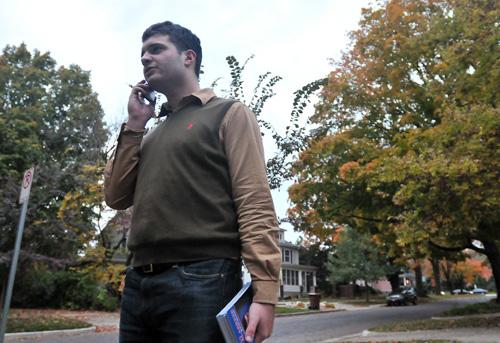In spite of technology, candidates go door-to-door for support

Republican Illinois House candidate Frank Calabrese talks on the phone with County Board candidate Tony Pomonis while in Champaign going door to door on Friday afternoon. Erica Magda
Oct 27, 2008
Last updated on May 13, 2016 at 04:04 p.m.
While those covering the presidential election might call Indiana a “battleground state,” the most important battleground for Lori DeYoung on Wednesday, Oct. 22 was situated a few miles away from the Indiana border.
That’s because DeYoung, a Democratic candidate for representative of the 104th District, spent the day rallying support by going door to door in Georgetown, Ill. The community is south of Danville, and is home to around 3,600 citizens, according to the 2000 census. With its smaller population and rural setting, Georgetown is the kind of place that DeYoung said is overlooked during elections.
“A lot of times, rural communities like this feel ignored,” DeYoung said. “They’re angry because they feel like they don’t have a voice.”
But while some of her knocks went unanswered, and though she admitted that a lot of voters have already decided who they’re going to vote for at this stage in the election, DeYoung said she will keep knocking until the end of the race.
Get The Daily Illini in your inbox!
For other candidates, considerable efforts are still being made to walk door-to-door. Bill Black, R-104th District, is DeYoung’s opponent and said he tries to go door to door at least three times a week. Naomi Jakobsson, D-103rd District, said she tries to walk and talk to constituents even if she’s not campaigning.
Frank Calabrese, Jakobsson’s opponent and senior in LAS, walked door to door in Champaign on Friday and said that he’s been walking since early September.
“Lately I’ve been going three to four times a week,” Calabrese said. “I think voter contact is by far one of the most important things in an election.”
In an era when politicians can contact voters virtually and establish campaign profiles on social networking Web sites, the door-to-door process might seem a bit old-fashioned. However, Michael Cheney, professor of communications at the Springfield campus and senior fellow at the Institute of Government and Public Affairs, said he believes smaller campaigns are not in a position to use these kinds of advances to a large extent.
“Take Barack Obama’s presidential campaign, for example,” Cheney said. “They’ve created a rich database of information on most every voter that they’ve ever interacted with, but even major campaigns have trouble pulling that off. So on a local level, there’s not enough funds or resources to incorporate technology like that.”
DeYoung said she does have a Web site, but added that she encountered some technical difficulties. Calabrese also has a Web site, but said he’s grown accustomed to going door to door to talk with voters.
“At first it’s kind of scary doing this, but you get used to it,” Calabrese said. “I’ve actually been invited in to people’s homes a lot more than I’ve been mistreated.”
But while local politicians are still going doortodoor to speak with and get information about voters, Cheney said certain technological advances may expedite this process further down the road.
“One of the things that will happen is that national campaigns will be able to parcel out information from their databases to places like the 104th District,” Cheney said. “This integration of technology would make a candidate’s ground game more effective.”
For now though, DeYoung said going door to door is more effective.
“I got so much publicity for going door to door during the Vermillion County Board race,” DeYoung said. “If I saw five houses spread out from each other, I would still knock on each of them. That’s what won it for me.”





